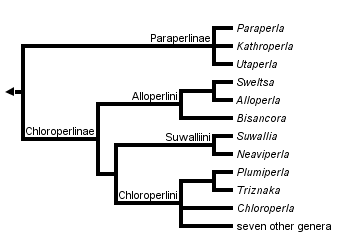Chloroperlidae
C. Riley Nelson


This tree diagram shows the relationships between several groups of organisms.
The root of the current tree connects the organisms featured in this tree to their containing group and the rest of the Tree of Life. The basal branching point in the tree represents the ancestor of the other groups in the tree. This ancestor diversified over time into several descendent subgroups, which are represented as internal nodes and terminal taxa to the right.

You can click on the root to travel down the Tree of Life all the way to the root of all Life, and you can click on the names of descendent subgroups to travel up the Tree of Life all the way to individual species.
For more information on ToL tree formatting, please see Interpreting the Tree or Classification. To learn more about phylogenetic trees, please visit our Phylogenetic Biology pages.
close boxIntroduction
Chloroperlidae consists of approximately 110 species divided between the nearctic, palearctic, and oriental regions. The nymphs are distinctive in having quite short legs and shortened cerci. Some genera are a common part of the general benthos in streams and rivers while others, especially the Paraperlinae, are exclusively hyporheic.
Characteristics
Zwick (1973) lists two synapomorphies of the Chloroperlidae as: 1, last palpal segment minute, conical, inserted asymmetrically on second to las segment; 2, caecal sacs of gut reduced. He lists the synapomorphy for the Paraperlinae as having the head elongate, with the temples parallel. He lists three synapomorphies for the Chloroperlinae: 1, tearing mandible of nymph secondarily present in adult; 2, distal portion of male epiproct no longer directed posteriorly but sharply bent to point forwar: basal rod flat and wide, largely fused to front margin of 10th segment; 3, anal fan of wing much reduced. Surdick (1985) presents phylogenetic information for the nearctic genera.
References
Nelson, C. H. 1984. Numerical cladistic analysis of phylogenetic relationships in Plecoptera. Ann. Entomol. Soc. Amer. 77: 466-473.
Surdick, R. F. 1985. Nearctic genera of Chloroperlinae (Plecoptera: Chloroperlidae). Illinois Biol. Monog. 54: 1-146.
Zwick, P. 1973. Insecta: Plecoptera. Phylogenetisches System und Katalog. Das Tierreich 94. Walter de Gruyter and Co., Berlin. 465 pp.
About This Page
C. Riley Nelson

Brigham Young University, Provo, Utah, USA
Page copyright © 1996
All Rights Reserved.
Citing this page:
Nelson, C. Riley. 1996. Chloroperlidae. Version 01 January 1996 (under construction). http://tolweb.org/Chloroperlidae/13954/1996.01.01 in The Tree of Life Web Project, http://tolweb.org/








 Go to quick links
Go to quick search
Go to navigation for this section of the ToL site
Go to detailed links for the ToL site
Go to quick links
Go to quick search
Go to navigation for this section of the ToL site
Go to detailed links for the ToL site